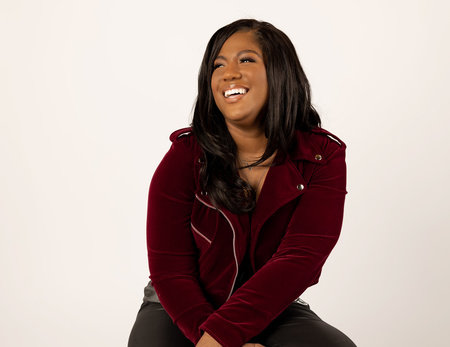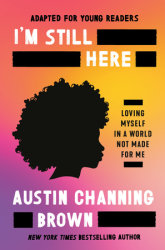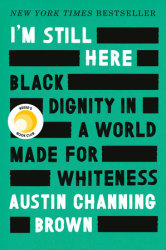At the end of I’m Still Here’s first chapter, Austin Channing Brown writes, “I offer this story in hopes that we will embody a community not afraid to name whiteness, celebrate Blackness, and in a world still run on systems of racial oppression, begin to see that there’s another way.” Filled with bravery, heart, and wisdom, Brown’s debut is as timely as it is true. Through Brown’s eyes readers discover the way race, gender, and religion can shape a person and how America’s failure to reckon with its past has impacted the soul and psyche of its citizens. I’m Still Here grapples with what it means to be Black, to be Christian, to be an activist, and to be a truth teller. Its pages are simultaneously searing and sincere. A gospel in its own rite, Brown’s story is a parable of survival and hope.
In celebration of I’m Still Here’s release, we spoke with Brown about the inspiration behind her book, her creative process, and the reason why intentionally celebrating Blackness matters.
PENGUIN RANDOM HOUSE: In the first chapter of your book you explore the exhaustion that goes hand in hand with being a Black American. What’s the earliest moment you can remember having to reckon with that exhaustion? Can you describe how you coped with that exhaustion and how your book has allowed for you to process the impact of the frustrations associated with existing in racist (and often times sexist) spaces?
AUSTIN CHANNING BROWN: I always knew that Austin was a “boys name.” I was very used to peers, teachers, and others trying to feminize my name when being introduced to me. Also, I grew up in the late eighties/early nineties when everything became personalized — keychains, toy license plates, plastic cups, etc. Every time I found the name Austin among the trinkets, I discovered it in blue or orange or the colors marked for boys. But the first time I was truly exhausted by this came around the age of eight when a librarian didn’t believe me when I told her my name. Rather than giving an awkward laugh and continuing the conversation, she treated me with suspicion. It made me really upset, and then my mother explained that she and my dad had purposefully given me a name that others would associate with white men in order to help my bypass discrimination.
Coping with the exhaustion of being a black woman in America has come in form of community. Sharing community with my parents and siblings, with my friends and especially other black women, is everything to me. Writing this book allowed me to take a step back to investigate my own feelings, emotions. I was able to ask myself, how does this feel? What is my first reaction when that happens? What is the right word to describe my thought process? It was both weird and invigorating trying to describe what it felt like to be in my body during different points in my life.
PRH: Your book grapples headfirst with the intersection of race, gender, and class. How has your multifaceted identity as an individual and as a writer shaped your creative process while writing I’m Still Here?
ACB: One of my rituals for writing was to always park myself under the photos of my ancestors. Looking into their faces or seeing their names on census records made it feel like their strength was in the room with me. I felt very much like I was holding space for their wisdom, and how their struggles live on today. It was comforting and challenging to write up to all that they endured — the foundation they laid for me.
PRH:The title of your book feels affirmational in away. It highlights how powerful it can be to remind those who fail to affirm your humanity (and the rights that go along with it) that you aren’t going to brush away their mistreatment. In a way, this reminder, embodied by the pages of your book, holds America’s past and present up to the light. You’re holding our nation accountable for its mistreatment of its citizens and the legacy that mistreatment fostered. How did writing your book give you solace about America’s fraught relationship with race? How did this project heal you?
ACB: I’m not sure that it healed me, but it did help me become clear about what I think about what I experience. There were thoughts I had that were kind of a jumbled mess, or questions I wasn’t sure I was prepared to answer. But having to write out declarative sentences forced me to ask myself what I truly believe about this country’s relationship to race. So I appreciate my own clarity, but I am also trying to give myself space to keep learning, keep growing, keep determining which declarations I stand by and which need to be modified. I hope never to outgrow that.
PRH:In the third chapter of your book, “The Other Side of Harmony,” you highlight the way white fragility and racism can alter the ideological application of religion and politics, and its impact on an individual’s sense of identity and self-esteem (the final sentences of the chapter come to mind here: “The lack of confrontation had done her no favors. As high school came to an end, I took this lesson with me and became determined always to question what looks like unity at first glance.”). This dilution of ideology and intention, due to the weight of systemic injustice, becomes a part of how people see the world and ultimately, how they treat others. Did writing your book help you find new ways to confront white fragility and its aftermath? How did I’m Still Here change your expectations of or hopes for building community and coalition across the color line?
ACB: It did! Writing this book allowed me to look back over a bunch of experiences talking about race, and decide when my own actions were healthy or unhealthy. For example, it was during the writing process that I realized how much more whole I feel when I confront white guilt by asking “so what will you do as a result?” If not for this project, I am not sure I would have become crystal clear as to why that reaction feels so much more healthy; and therefore allows me to continue to participate in this work.
PRH: In the “The Story We Tell,” you wrestle with the weight of American history and how the narratives we’re taught are true are often skewed and comprise erasures. Rather than telling the truth, much of what students learn in school is sanitized, a palatable retelling of something much more harrowing. Can you talk a bit about how this realization helped you reclaim your own history and how your search for the truth helped you tell your story?
ACB: Studying more about history helped me understand the experiences my own ancestors survived. During school, history was just a matter of dates and people I had to memorize for a test. But moving deeper into black history helped me connect to my own grandmother, great grandmother, and so on. I have greater appreciation for what each generation faced.
PRH:Towards the end of your book, you invoke the voices of James Baldwin and Audre Lorde as you unpack the ways in which rage and frustration can fuel creativity and action. Has working through your experiences as a Black American changed your creative vision or practice in any way?
ACB: Because of this project, I find myself thinking more about how I enter into racial justice conversations. I want to be more mindful, more intentional about celebrating blackness even as I continue to unpack whiteness. It’s important to me to continue finding ways to lift up black excellence, proclaim our inherent dignity, and celebrate the black community.
PRH:What was the most powerful lesson that writing I’m Still Here taught you?
ACB: That I can do hard, creative things … like write a book.














